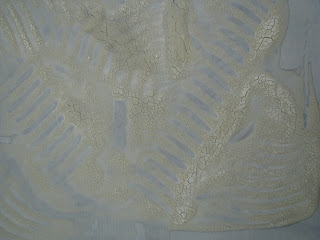
First, the word "resist," used as a noun, means a substance or object selectively placed on portions of the fabric you're working with to protect it from the dye or bleach or other transformative medium you plan to apply next. The "resisted" (transitive verb; interesting...) areas will be unaffected by whatever happens to the rest of the fabric.
A resist can be as simple as a wood or plastic block, strips of masking tape, or string. Many forms of Japanese shibori use the fabric itself as a resist, folded, stitched or scrunched so that the indigo dye penetrates unevenly. Remember tie-dye? When you wrapped those t-shirts in rubber bands or lengths of string, you were preparing fabric for resist dyeing. Who knew? We thought "resist" had only one meaning back in the '60s.
In this workshop, we played with two types of resist new to me: corn dextrin and potato dextrin. Both are powdered starches that mix with water to form a gloppy paste. You can brush or silk-screen them onto fabric, or stencil or stamp or rub them on. All kinds of found and repurposed materials come into play -- construction fencing, computer parts, plastic mesh produce baskets, ravioli presses, potato mashers. Believe me, when you get into this stuff, you'll never look at a hardware store, or your own kitchen, in quite the same way.
Potato dextrin is particularly cool to work with because, as it dries, it cracks in very interesting ways, as shown in the following photo. You can just spread it around on your fabric in a random manner, and then comb it around a bit. It's very much like finger-painting.

When the dextrin is dry, you apply dye all over, in a color or colors of your choice. You can use a roller with corn dextrin, since it dries smoothly. With potato dextrin, you have to dab the dye with a brush, as shown below, to make sure it penetrates through all the cracks and onto the fabric. Potato dextrin is all about the cracking.

Below are four of my pieces, all glopped up with dye and ready to sit overnight. You can always tell my work area by the ubiquitous Nalgene water bottle.

You let the dye dry and cure, and then wash off the resist to reveal your pattern. The photo at the top of this post shows the same four pieces, all washed and dried. Here's a closeup of one of them showing the wonderful crackly texture.





No comments:
Post a Comment